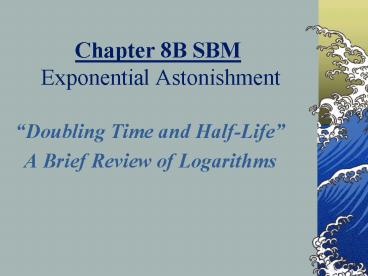Chapter 8B SBM Exponential Astonishment PowerPoint PPT Presentation
1 / 11
Title: Chapter 8B SBM Exponential Astonishment
1
Chapter 8B SBM Exponential Astonishment
- Doubling Time and Half-Life
- A Brief Review of Logarithms
2
A brief review of Logarithms...
- A Logarithm (or log) is a number that represents
a power or exponent. In this lesson, we will
focus on base 10 logs (or common logs), which are
defined as follows - log10 x is the power to which 10 must be raised
to obtain x or - log10 x means 10 to what power equals x?
Please Read page 476 on Log review
3
The Approximate Doubling Time Formula (Rule of 70)
- Consider the ecological study of a prairie dog
community from the lesson. (pages 470-471) - Look at Table 8.3 and note how the population
nearly doubles after 7 months. - This phenomenon is consistent with all doubling
times. We will not use the Rule of 70 but
instead the exact formulas on page 475 later in
power point
4
Doubling Time?
- The time required for each doubling in
exponential growth is called the Doubling time. - The magic penny from 8A had a doubling time of 1
day. - Given, this doubling time, we can easily
calculate the value of a quantity at any time.
(See the next slide!)
5
Calculating the Doubling Time
- After a time t, an exponentially growing quantity
with a doubling time of Tdouble increases in size
by a factor of 2 t / T double. - The new value of the growing quantity is related
to its initial value (at t 0) by - new value initial value X 2 t / T double
Please Look at Examples 1-4 (pg. 470-72)
6
Exponential Decay Half-Life
- Exponential Decay occurs whenever a quantity
decreases by the same percentage in every fixed
time period. . - (For example, by 25 each year).
- In that case, the value of the quantity
repeatedly decreases to half its value, with each
halving occurring in a time called the
half-life.
7
Calculations with the Half-Life
- After a time t, and exponentially decaying
quantity with a half-life of Thalf decreases in
size by a factor of (1/2) t / Thalf. - The new value of the decaying quantity is related
to its initial value (at t 0) by - new value initial value X (1/2) t / T half
Please Look at Examples 5-6 on page 473
8
Exact Formulas for Doubling Time and Half-Life
- As stated earlier, we will not be using the rule
of 70 due to it being inaccurate. So, for more
precise work or cases of larger rates where the
approximate formulas break down, we need exact
formulas and will use it for this class. - These formulas use the Fractional Growth Rate (r
P/100) - (For example, 15 per year is 0.15)
9
Exact Doubling Time Formula
- For an exponentially growing quantity with a
fractional growth rate r, the doubling time is - Note The units of time used for T and r must be
the same.(days, months, years...)
log10 2
Tdouble ?
log10 (1 r)
Please Look at Example 8 on page 475
10
Exact Half-Life Formula
- For an exponentially decaying quantity, we use a
negative value for r (for example -0.15 per year)
the half-life is - Note The units of time used for T and r must be
the same.(days, months, years...)
Thalf ? -
log10 2
log10 (1 r)
Please Look at Example 9 on page 475
11
Homework for 8B
- Part Is 3 - 4 (without a calculator) 5 8
(with a calculator) (you must show your work) - Part II s 9, 10, 13, 14, 17 - 19, 21 -
23, 31, 32, 35 - 37. - Extra credit 30 from 8B and/or 42 from
lesson 4A (page 218) (separate sheet)

